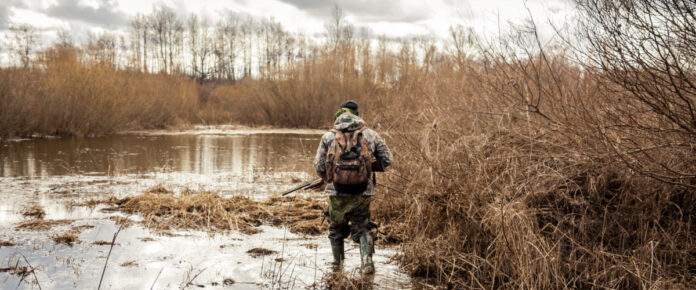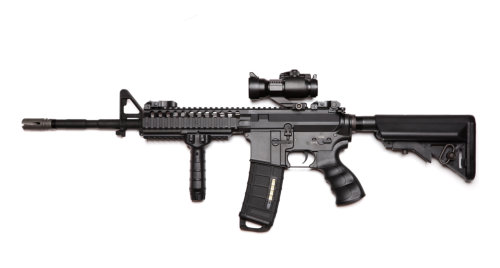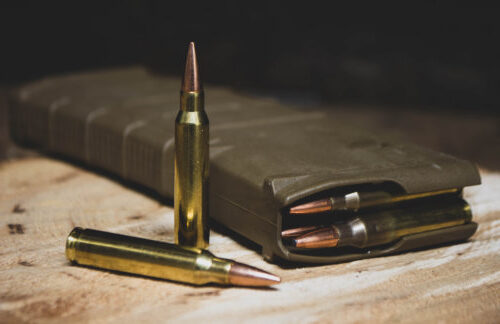
There are two answers the question of what is the best survival gun. They are:
Answer 1: The gun you have, and
Answer 2: There is no perfect survival gun.
Let’s dig into the answers a bit more closely.
Answer 1, “the gun you have,” is what I call a real-life answer. It simply means that if you are suddenly called upon to use lethal force, you will end up doing so with whatever gun you have at hand. Maybe that gun will be a Baby Browning .25 semi auto because that’s what you slipped into your pocket when you left the house that morning. Maybe it will be the .22 rifle you grabbed to shoot squirrels. Perhaps it will be the deer rifle you keep in the back of your truck.
The truth is we often don’t get a choice. I have a friend whose concealed-carry 9mm Khar pistol was used to put down a black bear that was mauling a dog. Was it the perfect gun for the task? No, but it was the only gun present and it did the job. When no other gun is present, you have to defend life with the gun you have.
If we knew we were going to be putting our lives in jeopardy, we’d have brought a bigger, more powerful gun (or two), worn a ballistic vest, and brought some friends, much like the paid professionals do when going into harm’s way. However, because lethal force situations, like most disasters, are usually unanticipated, we face them with our EDC gun, not our full armory.
Answer 2, “there is no perfect survival gun” is also correct, because we don’t know what your survival situation may be. The best rifle to hunt deer in a forest where a long shot is 80 yards is going to differ from the best rifle to hunt deer in the plains where a common shot might be several hundred yards. Neither one will be the best bet for shooting a squirrel or harvesting a goose when a flock flies over. We don’t know if you need a gun for hunting big game, harvesting small game, shooting waterfowl, defending yourself from 2-legged predators, or protecting the chicken flock from four legged ones, so we can’t pick a single “best” gun.
Similarly, the perfect gun for a 6’3” 240 pound male to use defending his home will be different than the perfect gun for his 14 year old 105-pound daughter to use.
Just as you need more than a bugout bag to survive, a single gun is a good start, but you’ll be better off with a collection of weapons that are each intended for a different purpose. We recommend a layered approach, where you start with a single gun and slowly build your survival armory based on your anticipated needs, the expected threat, the available personnel, and your environment.
The guns you choose should be the ones that fit you best, and fit means not only your situation, but your body type, size and strength. The best gun for you may well be the gun you shoot best.
The question of whether or not to add guns to your preparedness supplies is also a personal choice. The Pickled Prepper believes guns and the ability to use them effectively are an import part of a well-rounded preparedness plan. Just remember that those who beat their swords into ploughshares will plow for those who don’t.
Where to Start
Before you build your armory, you need to build your skills. A $1,000 gun is no better than a $100 gun in the hands of a person who can’t aim, doesn’t know how to chamber a round, and is as likely to shoot themselves or a buddy in the foot as they are to direct aimed fire at a target.
I believe that the best way to learn to shoot is from an NRA-certified firearms trainer and the worst way is to be taught by your spouse. Now I may be biased because I am NRA-certified trainer, but I have also trained with many professional trainers, and the key is to learn from a professional who can be objective and take emotion out of the equation. So while any competent shooter can most likely teach you to shoot, someone who trains people on a regular basis is undoubtedly your best bet. Even better if they can let you start with their guns and try you out on a couple, because not every gun is right for every person.
The second thing you need to do after receiving some training is to practice, because shooting is a skill that needs to be repeated to prevent it from deteriorating over time. I recommend using a .22 caliber rifle and or pistol for basic practice, because you can fire 10 or more .22LR bullets for the cost of a single larger caliber pistol or rifle bullet. So fire 100 rounds from your .22 and then a magazine from your full size weapon and you’ll have had a good practice session.
The Prepper’s First Gun
If you live in an urban area and your primary concern is self-defense, then your first purchase might be a handgun that can be carried on your person. This can be a semi-automatic pistol or a revolver; each has advantageous and disadvantages. I’ve carried both, so do some research and make your choice.
If you live in a rural area where your preference might be for a gun you can use in the woods, then a rifle might be more to your liking. Eventually, a good personal armory will include both a rifle and pistol, so the order in which you buy them is up to you.
If you want to develop you shooting skills, I recommend that the first gun you buy is a semiautomatic .22 caliber rifle, of which the Ruger 10/22 is my first choice. Anyone can use this compact little carbine to master the basics of safe gun handling and marksmanship. It can also harvest small game, and in a pinch you could use it for self-defense if you had no better option at hand (refer back to Answer 1). It shoots a common caliber that is usually inexpensive and more than 5 million 10/22s have been made. That kind of volume means you can find many YouTube videos about it and there are many after-market parts and accessories available, so it should be easy to fix or accessorize, if necessary.
Many other brand and styles of .22LR rifles will also make a good first gun, but we recommend semi auto. An exception is if you think you will be carrying a lever action rifle for hunting, you could opt for a lever action .22.
Whether you go with a pistol as your first or second gun, get a mid-sized or compact pistol from a good name brand such as Glock, Smith & Wesson, Sig Sauer, Ruger, CZ, Walther, Khar, Kel-tec, Colt, or Springfield Armory. (There are other brands out there, but do your research and avoid the least expensive brands.) The most important thing when you buy a pistol is how it feels to you and how it handles. You would not buy a car in which you cannot reach the brake pedal; don’t buy a gun where your trigger finger cannot comfortably reach the trigger. Get a gun that you can wrap your fingers around and can reach the trigger, and controls such as the safety and magazine release with minimal need to move your hand or adjust your grip.
I normally recommend a common caliber, like 9mm or .38 special for a survival arsenal, but the key is to get a pistol you can handle. If small hands or weak arms mean a smaller caliber with less recoil is better, then so be it. The key is to hit the target, and as someone wiser than I once said, a hit with a .22 is better than a miss with a .45.
The Next Step
After you have purchased a .22 rifle and a handgun, I recommend a 12-gauge shotgun or an AR-15 style rifle as your next purchase. Shotguns are often considered the preeminent close-range personal protection gun and can also be used to harvest game. While an AR-15 can be used for hunting, they are considered more a self-defense weapon and will have a longer range than a shotgun.
Some will recommend that the shotgun be your first purchase because it is a great home-defense weapon, and that’s hard to argue. However, if your goal is to become a well-rounded shooter who does not flinch at recoil, you’re better off starting with a .22.
Among shotguns, you will find that multiple gauges, which refers to the diameter of the barrel and the corresponding load of shot that it can carry/launch. 12 gauge is recommended because it is the most common and there will be more ammunition available, both in stores and for scrounging in a Mad-Max scenario. If you have smaller statured people who need lighter recoiling guns, try lighter or tactical loads in your 12 gauge before moving to a 20 gauge or .410 shotgun. The .410 can be an excellent gun for small game or for youth, but in most cases should not be your first shotgun.
You will find many models and styles of shotguns on the market, but I recommend a basic pump action such as the Mossberg 500 or 590 and the Remington 870. I personally prefer the Mossberg line because of the location of the safety, but both are well-made guns that should serve multiple generations. If money is an issue, look for a used gun rather than stepping down a no-name import.
A huge selection of AR-15 style weapons is on the market from so many manufacturers that I cannot name them all. Start with a basic model that includes front and rear sights, has a flat top instead of a carry handle, and a 16 to 16.5-inch barrel. Once you put a couple thousand rounds though it, you can decide what accessories you think would help you shoot more accurately or faster.

Your Basic Survival Armory
These four guns make up your basic prepper armory:
- A .22LR rifle
- A compact pistol
- A 12 gauge pump shotgun
- An AR-15 carbine
Again, the key to maintaining any degree of proficiency is to train regularly. I recommend shooting a minimum of 100 rounds per month, but there’s nothing wrong with practicing more often.
Your armory should include ammo and magazines. I recommend the following minimums:
- 2500 or more rounds of .22LR. and 6 magazines
- 500 or more rounds for your pistol with 6 magazines
- 2,000 rounds for your AR and a dozen magazines
- 500 for the shotgun, broken up between slugs, 00 buck, rounds for turkey, steel shot for waterfowl, and 7.5 shot for small game and practice.

Remember, these are minimums and there is no reason not to have more, other than the cost. Also, keep in mind that a magazine-fed gun is capable of firing only one shot at a time if you lose all the magazines. For that reason, we recommend that you keep half your magazines stored in a safe location.
It’s not unusual to meet preppers who have 100,000 rounds of ammo and several hundred magazines. While this may sound excessive, they think it’s a good investment. As we’ve said before, better to have extra than not enough.
Next Steps
If you look at a firearm as a tool, like your crescent wrenches or a shovel, then you don’t need any more weapons in your prepper’s armory as these four basic guns will cover most of your firearms needs. If over time, you find that you enjoy shooting and see value in hunting, you can consider adding a range of other weapons, such as:
- Guns for other family members
- A scoped hunting rifle
- A .308 battle rifle, such as the M14/M1A or AR10
- A semi-auto shotgun
- Full-size pistols, a .22 pistol, or smaller, back-up guns
- Other AR-15s, possibly with longer barrels, different optics, etc.
When buying new guns, we recommend that you stick with common calibers that are easy to find in sores and used by law enforcement and the military. These include .22LR, 9mm, .223 or 5.56, .30/30, 12 gauge, and .308. The next tier would probably include .38Spl/.357, .40S&W, .45ACP, 30-06, 7.62×39, and .300 Blackout.
There are countless versions and varieties of firearms, and some of them become quite specialized. Start with general guns that can meet many goals before you narrow it down and buy the firearm equivalent of a drag racer that can’t be used on the open road.
Remember, prepping is a journey, and not one accomplished overnight. If you buy only one gun a year, if four years you will have four guns. Be patient, don’t go into debt, work from a budget and you’ll reach your goal eventually.
Layers of Guns
Why do we mean by layers of guns? Let’s go back to the Answer 1, “the gun you have.” In most cases, the gun you have on you is a pistol. The purpose of the pistol is to allow you to defend yourself, break contact with the aggressor, and retreat to the place where you can access your more powerful long gun (which is a term meant to include rifles or shotguns, both of which are more power than a pistol.) Layers of guns simply means one gun backs up the other. If a gun breaks or jams, you have another. If you run out of ammo, you pull your backup.
There was a reason cowboys carried their rifles on the horse despite having a pistol on their hips. They could shoot further, were more accurate, and hit harder. If you find yourself in a situation where the rules of the Wild West seem to apply, rather than the current laws, then think like a cowboy, and make sure “the gun you have” is up to the task at hand.
Photo credits: Lead photo and image of the AR-15 are from Bigstock. The magazine and ammo photo is by Will Porada via unsplash.






